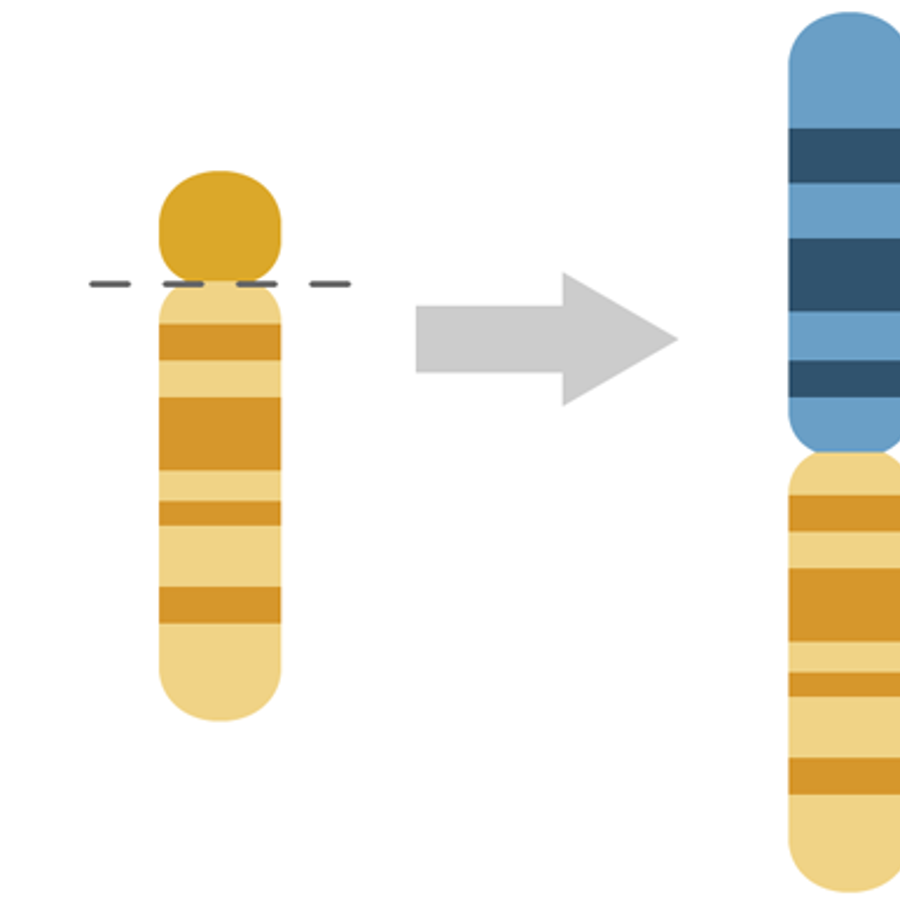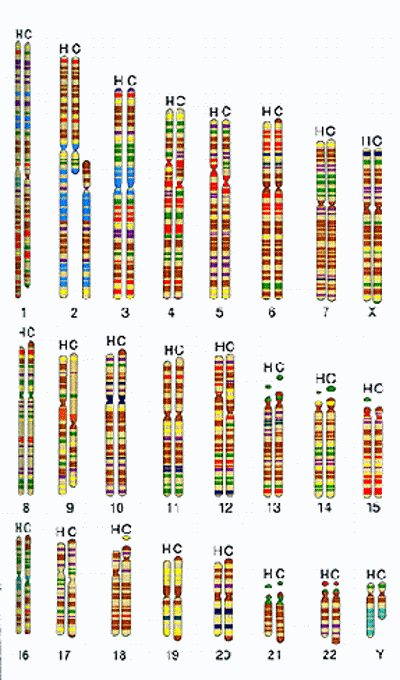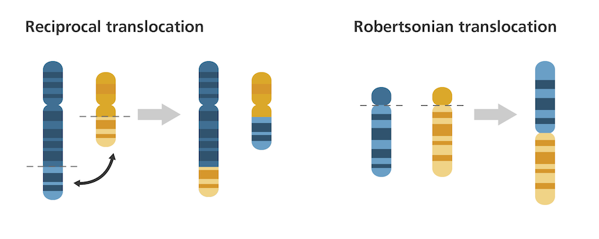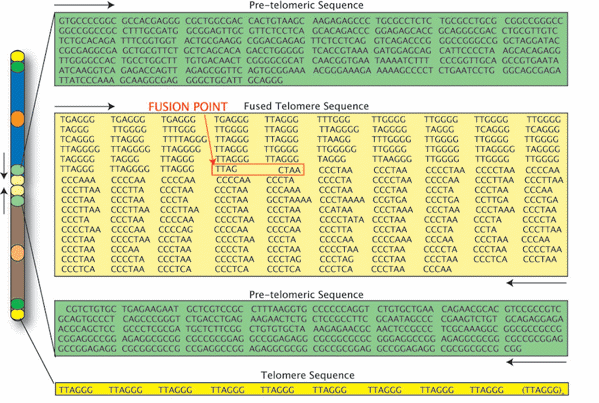
How did humans go from 48 to 46 chromosomes?
January 16, 2013

- Related Topics:
- Human evolution,
- Evolution,
- Chromosomes,
- Mutation,
- Translocation
A curious adult from California asks:
"I’ve been reading about how humans went from 48 to 46 chromosomes. How is this possible? Wouldn’t you end up with Down syndrome or something?"
It does look like our chromosome number went from 48 to 46 in our recent evolutionary past (think a million or so years ago). But it probably didn’t come with any of the symptoms associated with chromosomal diseases like Down syndrome. No, most likely its biggest impact was an increase in the number of miscarriages during the transition.
Despite all the bad press, there are actually a few situations where having fewer or more chromosomes than normal doesn’t have much of an effect. One of these is something called a balanced translocation.
In a balanced translocation, one chromosome sticks to another. The end result is 45 instead of 46 chromosomes, with very little DNA lost.
Because almost no DNA is lost, there are few symptoms associated with it. And balanced translocations aren’t just something that happened in our evolutionary past! Around 1 in 1000 people alive today has one.
Combining Chromosomes
Now this isn’t to say that having a balanced translocation is symptom free. Because it results in an unpaired chromosome, people with this odd number of chromosomes have a higher rate of miscarriages, and may have more trouble having kids. But they still can have kids and lead normal lives.
Having an odd number of chromosomes isn’t very stable. Cells prefer to have matching pairs of chromosomes, with an even number in total. The easiest way to fix this is to return back to the original 46. But it is also possible to go down to 44.
To get to the more stable 44 chromosomes, the most likely route is for two people with the same balanced translocation to have a child together. This can happen when two closely related people have kids. And this isn’t just theoretical; there are documented cases where this very thing has happened.
There are symptom-free people running around with 44 chromosomes who got to this number in this exact way. The most recent is a man from China but there are other documented cases in Finland and Spain too.
This sort of thing was almost certainly the first step in our move from 48 to 46 chromosomes. Basically there was a balanced translocation so there were 47 chromosomes and then there was a reduction to the more stable 46.
In fact, when you compare human and chimpanzee chromosomes, you can pretty easily see how chromosomes 12 and 13 of chimpanzees stuck together to give our chromosome 2. It is so obvious that scientists have renamed these chimpanzee chromosomes 2a and 2b!

The final step would be a situation where those with 46 chromosomes became isolated from those with 48 and where the 46’ers did better for some reason than the 48’ers. The end result is what we see right now, a world where most people have 46 chromosomes.
A key point here is that you see this kind of stuff in lots of different animals in the world. For example, wild mice have many different combinations of chromosomes because their chromosomes can so easily stick together. And they aren’t the only case, just the best studied one.
So not only are things like our chromosome number change possible, they are probable given enough time. The bottom line is that our DNA is not set in stone—it is incredibly dynamic.

Lopsided Bowties
As I said, people with a balanced translocation have about the same amount of DNA as you do.
There are actually a couple of different ways for translocations to happen. In a “reciprocal translocation”, two different chromosomes swap pieces. You still have the same number of chromosomes, but they’re a bit shuffled.
But a “Robertsonian translocation” is a bit different. In this type of translocation, one arm is lost on each chromosome. This is usually a very bad thing. Unless the chromosome is especially lopsided, that is…
(On a side note, these are named after the zoologist William Robertson. He was the first to describe this type of change, in 1916. Which he happened to notice in grasshoppers!)

Think of a chromosome as a sort of bow tie. One end is called the “P arm”, one end the “Q arm” and the middle the centromere. (Whichever end is longer is Q, and the shorter end is P.)
The most lopsided chromosomes (numbers 13, 14, 15, 21, and 22) all have one very short arm that doesn’t have a lot of information and one long arm that does. The Robertsonian translocations that work are the ones between these chromosomes where the two short arms are lost.
The man from China had his chromosomes 14 and 15 combined, while the families from Finland and Spain had their chromosomes 13 and 14 combined. These led to a loss of very little information so these folks were fine.
This is exactly what we see with chimpanzees and people too. Chromosomes 2a and 2b each have a long, information-rich arm and a shorter, information-light arm.
Chromosome 2 in people looks exactly like chromosomes 2a and 2b stuck together with most of their short arms lost…exactly what we would predict. In fact, if we take a closer look at where the two fused together, we can see where one leads into the other:

OK so over a million years ago there were a few humans running around with 46 chromosomes but most had 48. How did the 46 spread and eventually become the norm?
Advantage and/or Blind Luck
DNA changes can spread in a variety of ways. One of these is if there is some advantage to the new DNA change. The others involve simple luck.
At first glance, an advantage in this case doesn’t seem that likely. With little information lost or gained, it is pretty unlikely that the event that caused humans to have 46 chromosomes was much of an advantage.
But one possibility is that the group with 46 chromosomes ended up with a DNA change that was some sort of big advantage. Or that they started out with one that the folks with 48 chromosomes didn’t have.
These kinds of things happen all the time. For example in cultures that produce dairy, people who happen to be able to drink milk do better. And so on.
If the folks with 46 chromosomes did have the advantage, it would tend to stay within their group because of the high miscarriage rate with humans with 48 chromosomes. In other words, the advantage wouldn’t spread easily to folks with 48 chromosomes. Eventually the 46’ers would spread and take over.
Another possibility is simple luck. Imagine that the 48’ers and the 46’ers became separated somehow. Now some calamity wipes out the 48’ers (or most of them), sparing the 46’ers. In the eventual repopulating of the Earth, 46’ers would survive. In this case, the 46’ers didn’t have an advantage. They just got lucky.
Scientists call this genetic drift, and it is very common. The idea is that by chance, the human population drifted over to 46 chromosomes.
There is some evidence that something serious happened to people around 50,000-100,000 years ago. Scientists speculate that the total human population on Earth at this time was somewhere between 3,000 and 10,000 people. It may be that this population was isolated from the rest of humanity and they happened to have 46 chromosomes.
Of course we’ll probably never know exactly why people with 46 chromosomes replaced the ones with 48. But we do know that these things can and do happen in the wild all the time. And we can come up with plausible ways to get from 48 to 46 chromosomes that don’t involve serious side effects.
Read More:
- KQED: A volcanic eruption that may have almost wiped humans out
- KQED: More on a 44 chromosome man
- Khan Academy: More on genetic drift
- A support group for people with rare chromosome disorders has an info sheet on balanced translocations

Author: Dr. D. Barry Starr
Barry served as The Tech Geneticist from 2002-2018. He founded Ask-a-Geneticist, answered thousands of questions submitted by people from all around the world, and oversaw and edited all articles published during his tenure. AAG is part of the Stanford at The Tech program, which brings Stanford scientists to The Tech to answer questions for this site, as well as to run science activities with visitors at The Tech Interactive in downtown San Jose.
 Skip Navigation
Skip Navigation
